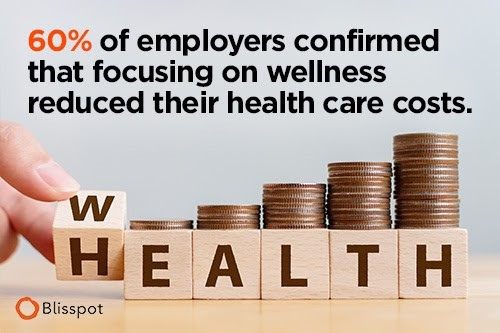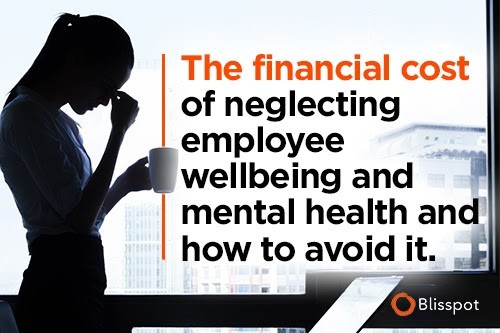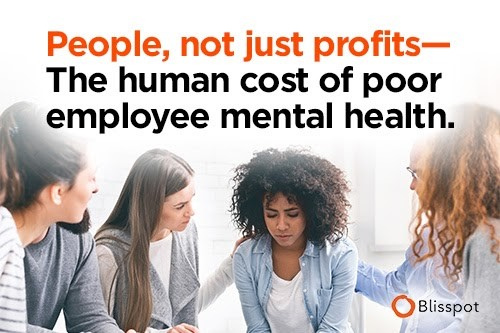What You Can Do to Maximize Your ROI with Workplace Wellbeing
When it comes to the human and financial costs to businesses of neglecting mental health, the evidence in this article shows that you can’t afford not to invest in the wellbeing of your people.
Fortunately, there are several effective initiatives that you and your company can put in place to enhance mental health and wellbeing in the workplace. These will not only increase productivity by reducing absenteeism and burnout, but also improve the working environment for you and your team.
Why Do Successful Organizations Commit to Employee Wellbeing?
The simple answer is that employee wellbeing boosts productivity, lowers healthcare expenses, and can even boost profits. In fact, a Harvard study found that employee wellness programs actually gave a 6:1 Return On Investment (+ROI)—more on that later
This article will show you how to avoid the costs by implementing an effective wellbeing program that is easy, affordable, and will benefit your business, such as the wellbeing solution from Blisspot.
How Much Is It Costing You Not Investing in Workplace Wellbeing? It Has a Numerical Value
Businesses lose $1 trillion every year in productivity owing to employee mental health difficulties, according to the World Health Organisation (WHO).
You may even be feeling the strain yourself, with 88% of founders extremely stressed, as reported by KPMG. Workplace wellbeing schemes may not feel like a priority, when there’s so much to juggle and so many other things competing for your time, attention, and budget. However, your health and wellbeing should absolutely be a top priority, along with your team, as this is vital to your business.
Proactively focusing on wellbeing can actually help reduce health care costs, decrease absenteeism, boost engagement, and increase productivity. Even better, wellness initiatives don’t have to be expensive, making them an attractive investment for any budget.
How Ignoring Your Employee Health and Wellness Is Bad for Business
Health and wellness difficulties caused a 74% increase in anxiety, 58% increase in depression, and a 28% increase in stress during a three-year study of worldwide employees.
How detrimental is this to companies? Consider that 61% of workers say they’re burned out while 31% report extremely high stress levels.
Addressing medical conditions once they have escalated, depletes both healthcare resources and workflow productivity, which is expensive.
The financial penalties are staggering—failing to pay attention to workers’ mental health drains $153 billion from U.S. businesses.
Companies Can’t Afford Not to Promote Wellness Initiatives
Prioritizing employee wellbeing and supporting mental health isn’t a new-age fad or “nice to have” perk. It’s fundamental to your business. Studies have proven that it leads to healthier, more engaged employees and a better bottom line.
Gallup research found that employees with high overall wellbeing had 41% lower health-related expenses and 62% lower costs than those who are suffering. People with thriving wellbeing have a 35% lower turnover rate than those who are struggling.
How much is a day of full productivity worth to your business versus the costs of a wasted day off sick?

60% of employers confirmed that focusing on wellness reduced their health care costs.
It is not necessary to spend a lot of money on health and wellbeing – you can spend it smartly on affordable solutions. For example, you can outsource this to the experts at Blisspot and get access to over 80 therapists, psychologists, doctors and coaches sharing over 160 life-enhancing resources from just AUS $15 a month.
The business benefits far exceed the small investment. As we touched on at the beginning, when considering the Return On Investment (ROI), Harvard researchers found that for every dollar spent on employee wellness activities and programs, employers saved $3.27 and absenteeism costs dropped by $2.73, resulting in a 6:1 ROI.
Let’s look at how to maximise the return on both the financial and human costs in more detail.

The Financial Cost of Neglecting Employee Wellbeing and Mental Health and How to Avoid It
1. Absenteeism
Mental health issues continue to be one of the primary reasons for absenteeism in the workplace.
Employees who suffer from mental health issues may face emotional and physical symptoms that force them to miss work. This can lead to a drop in productivity, which can be costly to businesses.
It has been recorded that employees with depression miss on average 27 days of work per year, and the cost of depression-related absenteeism is $4,426.59 per capita and $9619 for bipolar disorder (BPD).
Depression, which is often hidden by employee’s due to stigmatisation, accounts for half of all disability in people of working age. This is more than the combined effects of back pain, heart pain, pulmonary problems, diabetes, and cancer. In ‘more economically developed countries’, mental health issues account for more than one-third of all disability and absence.
Absence may also have a knock-on effect, leading to an increased workload and potential risk for work-related stress in remaining team members.
2. Presenteeism
Businesses must also deal with presenteeism in addition to absenteeism. Employees who are able to come to work but have ill health symptoms that negatively influence their productivity is referred to as presenteeism.
Time management, focus, physical work, attention to detail, and communication are all challenges that can become harder with ill health. This can result in missed deadlines, project management issues, and other errors that cost businesses time and money.
Presenteeism costs firms 10 times more than absenteeism, according to a report by the Global Corporate Challenge (GCC). Employers lose around $150 billion per year due to absent workers, while a staggering $1,500 billion ($1.5 trillion) is lost due to employees who went to work but were not entirely productive. This means that it is significantly more costly to have someone at work who isn’t well than when the employee isn’t even present!
3. Turnover and lost talent – recruitment and rehiring costs
More money is spent on recruiting, hiring, and retraining new staff when turnover rates are high.
According to the Institute for Research on Labor Employment, replacing an employee in California costs on average $4,000. These expenses will differ based on the size of the company, the industry, and other employer-specific considerations. Where there is a loss of highly trained people as a result of poor mental health, additional recruitment and training costs are incurred by the employer.
Replacing a lost employee costs between 33% and 150% of yearly salary, depending on competence and seniority, and has a negative impact on operations, morale, and competitiveness as organizations lose experienced individuals.
Staff turnover is an underestimated drain on the bottom line since mental health issues can lead to higher recruiting and retention costs. Employees with depression are 20% more likely than their peers to lose their jobs after two years.
Employee wellbeing and low turnover are inextricably linked.
According to Mercer’s National Survey of Employer-Sponsored Health Plan, companies that foster healthy cultures had an 11% lower turnover rate than companies that do not promote employee wellbeing.
A survey of over 1,000 Americans found that a huge 80% of employees would leave their present workplace for one that focused more on mental health, so building a mutually beneficial work environment will result in higher employee retention.
4. Boost your business brand and culture
Your company’s capacity and readiness to respond sensitively and effectively to employee well-being and mental health will become an important aspect of your brand and culture, enhancing your reputation for social responsibility as well as your ability to recruit and retain top talent.
Measurable improvements in wellbeing does not just look good to key stakeholders and enhance your brand and public relations, however, it will also lead to improved employee relations.
This results in a more unified and productive culture as well as considerable cost savings through the prevention of long-term mental health issues.
Your team are your most valuable brand ambassadors.
Businesses are in the limelight much more than in the past, because of the prevalence of social media and online visibility. This might make all the difference in attracting and retaining top talent, as well as prospects.
However, a company’s brand can be harmed in an instant, and companies that aren’t as supportive of their employees’ mental health may see this reflected in online reviews, comments, and scores.
Glassdoor, for example, is frequently used by potential applicants before determining whether or not to apply to a company, therefore the talent loss of employees who didn’t feel supported could be significant.
What about the costs to small and medium businesses (SMEs)?
“Only major firms can afford to adopt a mental health program for their employees.” “Isn’t it true that it would be too expensive for SME owners?” These are common but costly mistakes to make.
Because SMEs have narrower profit margins, losing personnel is extremely significant.
SME owners lose almost $42,000 every year due to staff turnover. The cost is determined by the amount of money spent on recruiting as well as the amount lost in productivity from people quitting their jobs.
“Organizations are increasingly focusing on mental wellbeing and appreciate that there is a moral and financial advantage of doing this,” says Dr. Mark Winwood, Director of Psychological Services at AXA PPP healthcare.
There are several expenses associated with poor mental, emotional, and physical health at work. The obvious one is revenue, but poor workplace wellbeing strategies can also result in the loss of business brand and talent, as we’ve just assessed.
However, let us not forget that behind every statistic is a real human life story. It goes without saying that poor mental health has a significant human cost. Not to mention the enormous emotional toll on those who are affected.

People, not just profits—The human cost of poor employee mental health
Behind all the aforementioned data and dollars are people. Suffering from mental illness is an extremely isolating and difficult experience, and individuals need help now more than ever.
Employees spend a lot of their time at work, whether physically or online, thus it is critical they be well-supported. Besides providing a return on investment (ROI), wellness programs have been proven to not only reduce sick days and healthcare expenses and increase productivity but also stimulate innovation and job contentment.
Investing in people’s wellbeing is a genuine opportunity. People may reach optimum performance when they feel rested, nourished, secure, and like they belong, which has been found to enhance productivity by 300%.
So far we have looked at workplace wellness program evaluations in terms of hard-dollar returns — the amount of money spent vs the amount saved. The potential to develop an organization’s culture and promote employee pride, trust, and dedication mustn’t be overlooked.
5. Lower morale, innovation, and top line growth
Because workplace wellness is a collaboration between employee and employer, it necessitates trust. Personal health is such a personal matter, so investing in wellness may foster strong ties when done well.
Trust blossoms within healthy teams, which decreases the effects of stress and burnout while also improving team performance in terms of cooperation and efficiency.
It has been proven that employees that are healthy and well outperform their peers. They arrive prepared to work, resulting in a 6x return on wellness investments.
6. Drops employee engagement
Employee engagement is the gold standard for company success. Ideally you want people to bring their best self to work, go above and beyond the call of duty, to help their employers and clients achieve their greatest objectives.
Employees who are in good physical and mental health are almost twice as likely to be engaged and like their jobs.
According to Virgin Pulse’s 2017 State of the Industry Survey, organizations that invested in employee engagement witnessed a 56% increase in employee satisfaction, 40% saw improved corporate culture, and 14% an increase in revenue as a consequence of their employee engagement initiatives.
7. Worsens customer service
Good customer service is critical to a company’s success. Customer service is linked to higher levels of repeat business, and customers are willing to spend more for a positive customer experience.
Businesses that thrive at customer service usually also enjoy improved financial outcomes. While strong customer service and staff wellness go hand in hand, bad customer service and low employee wellbeing also have a strong correlation.
Employees carry their troubles to work when they are overworked, anxious, or have financial challenges. This may lead to poor customer service in frontline staff, and in this day and age of social media, it only takes a few unpleasant encounters to damage a company’s brand reputation.
Employees with a strong sense of wellbeing, on the other hand, are more likely to deliver excellent customer service, exhibit greater passion at work, and be more productive. Of course, this enhances bottom lines and provides a genuine return on investment.
What Can You Do to Maximise Your ROI With Workplace Wellbeing?
Employers face a tremendous healthcare dilemma, and there is just too much at stake to be reactive.
It’s time for businesses to take the offensive rather than the defensive strategy. According to one productivity expert, a firm should spend $300-$400 per person on wellness to have a strong return on investment. This can cost as little as US $25 per month over the course of a year, which is extremely doable.
Here at Blisspot, we go one better… We offer a whole personal playground of wellbeing tools completely free and Blisspot subscription is very affordable at just Aus $15 a month (around $10US or just £8, mere cents and pence a day).
Blisspot Aims to Make Proven and Effective Mental Health Programs Accessible to All
Workplace wellbeing in the workplace is at a crossroads, and businesses must reformulate employee wellbeing as a potent tool for commercial success.
Blisspot provides an affordable and accessible solution for wellbeing at work. We are, in effect, redefining employee wellness ROI so that firms can remain competitive and profitable by having engaged, happier, and healthier employees.
Blisspot is on a mission to empower wellbeing for life, with a community of over 80 wellbeing experts including doctors, psychologists, therapists, scientists, coaches, and empowerment leaders, providing world-class education, a wide range of health and wellness solutions, and personalized support on a wide range of topics.
There’s a whole body of expertise and work on a wide range of topics including mindfulness, mental and physical health, stress relief, sleep, resilience, relationships, parenting, nutrition, emotional mastery and more. Learn more about how our employee wellness tools can lead to a happier and healthier workforce.
The Bottom Line: It Makes Business Sense, Financial Sense, and Human Sense.
The business case has been well and truly made. Wellness programs don’t have to be expensive, and they deliver an excellent return on investment, helping you attract and retain top talent, lowering absenteeism and healthcare expenses, promoting employee engagement, boosting productivity, and improving your business performance.
So, What Steps Will You and Your Organization Take to Improve Employee Mental Health This Year?
Here’s a good place to start – enter your details below to arrange a demo today and find out just how much Blisspot can improve your employees’ mental wellbeing and productivity.







